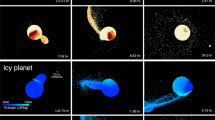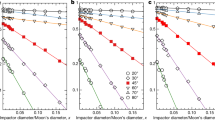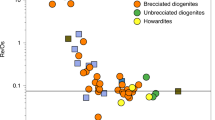Abstract
Most of the properties of the Earth–Moon system can be explained by a collision between a planetary embryo (giant impactor) and the growing Earth late in the accretion process1,2,3. Simulations show that most of the material that eventually aggregates to form the Moon originates from the impactor1,4,5. However, analysis of the terrestrial and lunar isotopic compositions show them to be highly similar6,7,8,9,10,11. In contrast, the compositions of other Solar System bodies are significantly different from those of the Earth and Moon12,13,14, suggesting that different Solar System bodies have distinct compositions. This challenges the giant impact scenario, because the Moon-forming impactor must then also be thought to have a composition different from that of the proto-Earth. Here we track the feeding zones of growing planets in a suite of simulations of planetary accretion15, to measure the composition of Moon-forming impactors. We find that different planets formed in the same simulation have distinct compositions, but the compositions of giant impactors are statistically more similar to the planets they impact. A large fraction of planet–impactor pairs have almost identical compositions. Thus, the similarity in composition between the Earth and Moon could be a natural consequence of a late giant impact.
This is a preview of subscription content, access via your institution
Access options
Subscribe to this journal
Receive 51 print issues and online access
$199.00 per year
only $3.90 per issue
Buy this article
- Purchase on Springer Link
- Instant access to full article PDF
Prices may be subject to local taxes which are calculated during checkout


Similar content being viewed by others
References
Canup, R. M. & Asphaug, E. Origin of the Moon in a giant impact near the end of the Earth’s formation. Nature 412, 708–712 (2001)
Agnor, C. B., Canup, R. M. & Levison, H. F. On the character and consequences of large impacts in the late stage of terrestrial planet formation. Icarus 142, 219–237 (1999)
Jacobson, S. A. & Morbidelli, A. Lunar and terrestrial planet formation in the Grand Tack scenario. Phil. Trans. R. Soc. Lond. A 372, 20130174 (2014)
Canup, R. M. Simulations of a late lunar-forming impact. Icarus 168, 433–456 (2004)
Canup, R. M. Lunar-forming collisions with pre-impact rotation. Icarus 196, 518–538 (2008)
Ringwood, A. E. Terrestrial origin of the moon. Nature 322, 323–328 (1986)
Lugmair, G. W. & Shukolyukov, A. Early solar system timescales according to 53Mn-53Cr systematics. Geochim. Cosmochim. Acta 62, 2863–2886 (1998)
Wiechert, U. et al. Oxygen isotopes and the Moon-forming giant impact. Science 294, 345–348 (2001)
Touboul, M., Kleine, T., Bourdon, B., Palme, H. & Wieler, R. Late formation and prolonged differentiation of the Moon inferred from W isotopes in lunar metals. Nature 450, 1206–1209 (2007)
Zhang, J., Dauphas, N., Davis, A. M., Leya, I. & Fedkin, A. The proto-Earth as a significant source of lunar material. Nature Geosci. 5, 251–255 (2012)
Herwartz, D., Pack, A., Friedrichs, B. & Bischoff, A. Identification of the giant impactor Theia in lunar rocks. Science 344, 1146–1150 (2014)
Franchi, I. A., Wright, I. P., Sexton, A. S. & Pillinger, C. T. The oxygen-isotopic composition of Earth and Mars. Meteorit. Planet. Sci. 34, 657–661 (1999)
Clayton, R. N. & Mayeda, T. K. Oxygen isotope studies of achondrites. Geochim. Cosmochim. Acta 60, 1999–2017 (1996)
Asphaug, E. Impact origin of the Moon? Annu. Rev. Earth Planet. Sci. 42, 551–578 (2014)
Raymond, S. N., O’Brien, D. P., Morbidelli, A. & Kaib, N. A. Building the terrestrial planets: constrained accretion in the inner Solar System. Icarus 203, 644–662 (2009)
Ćuk, M. & Stewart, S. T. Making the Moon from a fast-spinning Earth: a giant impact followed by resonant despinning. Science 338, 1047–1052 (2012)
Canup, R. M. Forming a Moon with an Earth-like composition via a giant impact. Science 338, 1052–1055 (2012)
Chambers, J. E. A hybrid symplectic integrator that permits close encounters between massive bodies. Mon. Not. R. Astron. Soc. 304, 793–799 (1999)
Raymond, S. N., Kokubo, E., Morbidelli, A., Morishima, R. & Walsh, K. J. Terrestrial planet formation at home and abroad. In Protostars and Planets VI (eds Beuther, H., Klessen, R., Dullemond, C. & Henning, Th.), 585–618 (University of Arizona Press, 2014)
Raymond, S. N., Quinn, T. & Lunine, J. I. High-resolution simulations of the final assembly of Earth-like planets. I. Terrestrial accretion and dynamics. Icarus 183, 265–282 (2006)
Pahlevan, K. & Stevenson, D. J. Equilibration in the aftermath of the lunar-forming giant impact. Earth Planet. Sci. Lett. 262, 438–449 (2007)
Belbruno, E. & Gott, J. R., III Where did the Moon come from? Astron. J. 129, 1724–1745 (2005)
Salmon, J. & Canup, R. M. Lunar accretion from a Roche-interior fluid disk. Astrophys. J. 760, 83 (2012)
Reufer, A., Meier, M. M. M., Benz, W. & Wieler, R. A hit-and-run giant impact scenario. Icarus 221, 296–299 (2012)
Dauphas, N., Burkhardt, C., Warren, P. & Teng, F.-Z. Geochemical arguments for an Earth-like Moon-forming impactor. Phil. Trans. R. Soc. Lond. A 372, 20130244 (2014)
Elliott, T. & Stewart, S. T. Planetary science: shadows cast on Moon’s origin. Nature 504, 90–91 (2013)
Acknowledgements
H.B.P. acknowledges support from BSF grant number 2012384, the Minerva Center for Life under Extreme Planetary Conditions, the ISF I-CORE grant number 1829/12 and the Marie Curie IRG 333644 ‘GRAND’ grant. S.N.R. acknowledges funding from the Agence Nationale pour la Recherche via grant ANR-13-BS05-0003-002 (project MOJO). We thank O. Aharonson for remarks on an early version of this manuscript. We thank N. Kaib and N. Cowan for helpful discussions on their related work.
Author information
Authors and Affiliations
Contributions
A.M.-B. analysed the simulation data and produced the main results; H.B.P. initiated and supervised the project and took part in the data analysis. S.N.R. provided the simulation data used for the analysis. The paper was written by A.M.-B. and H.B.P. with contributions from S.N.R.
Corresponding authors
Ethics declarations
Competing interests
The authors declare no competing financial interests.
Extended data figures and tables
Extended Data Figure 2 The cumulative distribution of the planetesimals composing the planet (red) and the impactor (blue).
All planet–impactor pairs in Table 1 are shown, cases 13–20 (panels m–t).
Extended Data Figure 3 The cumulative distributions of the compositions of planets and last impactors assuming 0% mixing between Earth and Moon material.
The cumulative distribution of the absolute Δ17O differences between planets and their last giant impactors (blue), compared with the differences between planets in the same system (red), assuming 0% mixing between Earth and Moon material. From the top left panel (a) to the bottom right panel (f) we consider all the systems, regardless of the number of particles that contributed to their formation, and planets and last impactors composed of a minimum of 10, 20, 40 and 50 particles. Only last impactors with mass >0.5MMars have been taken into account.
Extended Data Figure 4 The cumulative distributions of the compositions of planets and last impactors assuming 20% mixing between Earth and Moon material.
The cumulative distribution of the absolute Δ17O differences between planets and their last giant impactors (blue), compared with the differences between planets in the same system (red), assuming 20% mixing between Earth and Moon material. From the top left panel (a) to the bottom right panel (f) we consider all the systems, regardless of the number of particles that contributed to their formation, and planets and last impactors composed of a minimum of 10, 20, 40 and 50 particles. Only last impactors with mass >0.5MMars have been taken into account.
Extended Data Figure 5 The cumulative distributions of the compositions of planets and last impactors assuming 40% mixing between Earth and Moon material.
The cumulative distribution of the absolute Δ17O differences between planets and their last giant impactors (blue), compared with the differences between planets in the same system (red), assuming 40% mixing between Earth and Moon material. From the top left panel (a) to the bottom right panel (f) we consider all the systems, regardless of the number of particles that contributed to their formation, and planets and last impactors composed of a minimum of 10, 20, 40 and 50 particles. Only last impactors with mass >0.5MMars have been taken into account.
Supplementary information
Supplementary Tables
This file contains Supplementary Table 1. (PDF 109 kb)
PowerPoint slides
Rights and permissions
About this article
Cite this article
Mastrobuono-Battisti, A., Perets, H. & Raymond, S. A primordial origin for the compositional similarity between the Earth and the Moon. Nature 520, 212–215 (2015). https://doi.org/10.1038/nature14333
Received:
Accepted:
Issue Date:
DOI: https://doi.org/10.1038/nature14333
This article is cited by
-
The accretion of planet Earth
Nature Reviews Earth & Environment (2022)
-
The Exosphere as a Boundary: Origin and Evolution of Airless Bodies in the Inner Solar System and Beyond Including Planets with Silicate Atmospheres
Space Science Reviews (2022)
-
The origin of the Moon’s Earth-like tungsten isotopic composition from dynamical and geochemical modeling
Nature Communications (2021)
-
Carbon monoxide gas produced by a giant impact in the inner region of a young system
Nature (2021)
-
Distinct oxygen isotope compositions of the Earth and Moon
Nature Geoscience (2020)
Comments
By submitting a comment you agree to abide by our Terms and Community Guidelines. If you find something abusive or that does not comply with our terms or guidelines please flag it as inappropriate.



